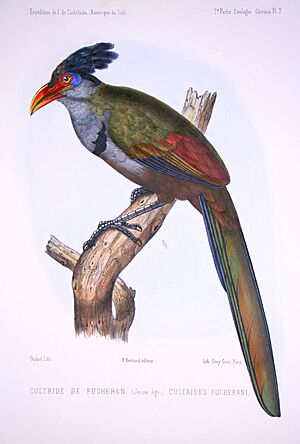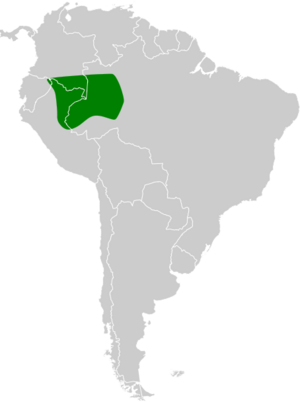Red-billed ground cuckoo facts for kids
Quick facts for kids Red-billed ground cuckoo |
|
|---|---|
 |
|
| Conservation status | |
| Scientific classification | |
| Genus: |
Neomorphus
|
| Species: |
pucheranii
|
 |
|
The red-billed ground cuckoo (Neomorphus pucheranii) is a special type of cuckoo bird. It lives mostly on the ground in the forests of South America. You can find it in countries like Brazil, Colombia, and Peru. It might also live in Ecuador.
Contents
About This Bird
The red-billed ground cuckoo belongs to the cuckoo family. It has two slightly different groups, called subspecies. Think of subspecies like different versions of the same animal that live in different places or have small differences in how they look.
What It Looks Like
The red-billed ground cuckoo is a medium-sized bird. It is about 43 to 55 centimeters (17 to 22 inches) long. About half of its length is its long tail! One male bird weighed about 330 grams (11.6 ounces).
These birds have a thick, curved bill that is red or orange. The tip of the bill can be green or yellow. Both male and female birds look very similar.
- Head and Body: Adults have a dark bluish-black head with a shaggy crest. Their neck and back are olive brown. Their tail is dark chestnut.
- Wings: Their wings are mostly reddish-brown. The outer feathers are black with a shiny violet-blue color.
- Face: Their face is gray with red skin around their eyes. Behind their eyes, the skin is bright blue.
- Underparts: Their throat is gray, and their chest is gray with a black band below it. Their belly is light gray or buffy.
Young red-billed ground cuckoos look a bit different. They have brown upper parts and a blackish crest. Their wings are purplish-chestnut, and their throat and chest are black.
The second subspecies, N. p. lepidophanes, looks similar. However, its chest and belly are more clay-colored instead of light gray. Its chest feathers also look more "scaled."
Where It Lives
The red-billed ground cuckoo lives in the upper Amazon basin. One subspecies is found in eastern Peru and western Brazil, north of the Amazon River. The other subspecies is found in the same areas but south of the Amazon River.
These birds like to live in moist lowland evergreen forests. They often prefer areas with slightly hilly ground and well-drained soil. They can be found at elevations up to 700 meters (2,300 feet).
How It Behaves
The red-billed ground cuckoo stays in its home area all year round. It does not migrate.
Movement
This bird spends almost all of its time on the ground. It mostly walks or runs through the forest. It might fly low to the ground or hop into a tree if it needs to escape danger. It also makes leaps to catch its food.
What It Eats
Scientists haven't studied the red-billed ground cuckoo's diet a lot. However, we know it mostly eats insects. It also eats other small creatures like spiders. Sometimes, it will eat small animals like lizards, frogs, or even tiny birds. It might also eat fruits.
These clever birds often follow army ant swarms. They also follow groups of peccaries (wild pigs) or monkeys. They do this to catch prey that is trying to escape from the ants or peccaries. They also eat fruits that monkeys drop.
Life Cycle and Reproduction
We don't know much about how red-billed ground cuckoos raise their young. Their nests have not been described by scientists. In 1855, someone observed a nest with two eggs. Both the male and female birds were taking turns sitting on the eggs.
Sounds It Makes
The red-billed ground cuckoo's song is a short, deep, rising hoot. It makes about one hoot every two seconds.
Interestingly, these cuckoos have been seen making sounds that copy peccaries. They might do this for a few reasons. Peccaries can protect their group from predators. So, by sounding like peccaries, the cuckoos might trick predators into thinking peccaries are nearby. This could also help both the cuckoos and the peccaries by warning each other about danger.
Conservation Status
The IUCN (International Union for Conservation of Nature) has listed the red-billed ground cuckoo as a species of "Least Concern." This means that it is not currently in danger of disappearing. It lives in a very large area, and its population seems to be stable.
No immediate threats have been found for this bird. However, because it relies on tropical evergreen forests, it could be affected if these forests are cut down or broken into smaller pieces.


